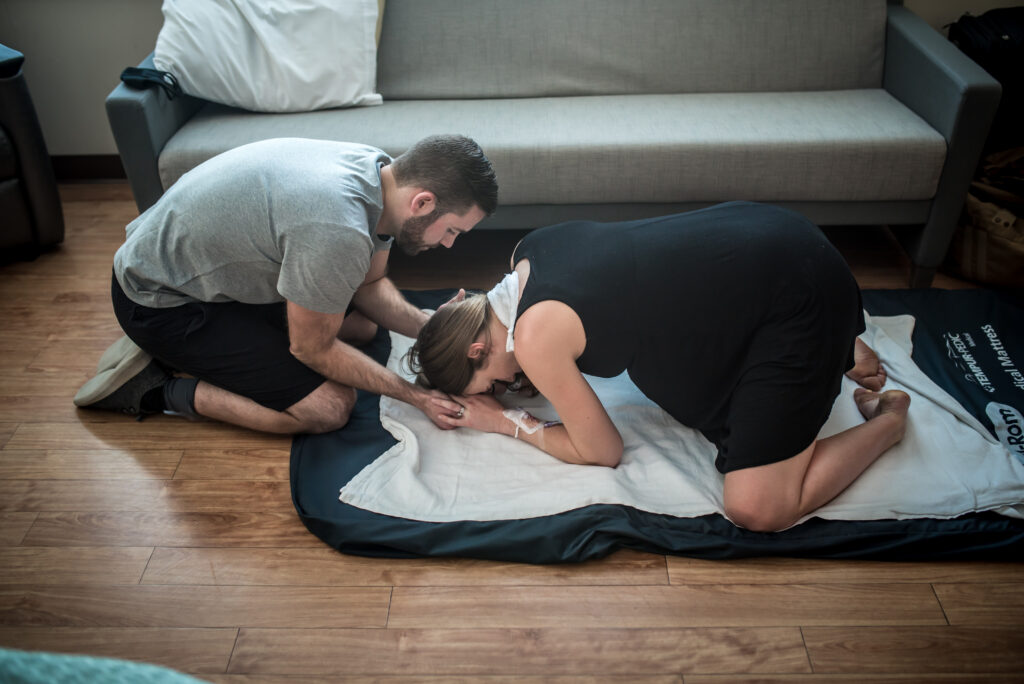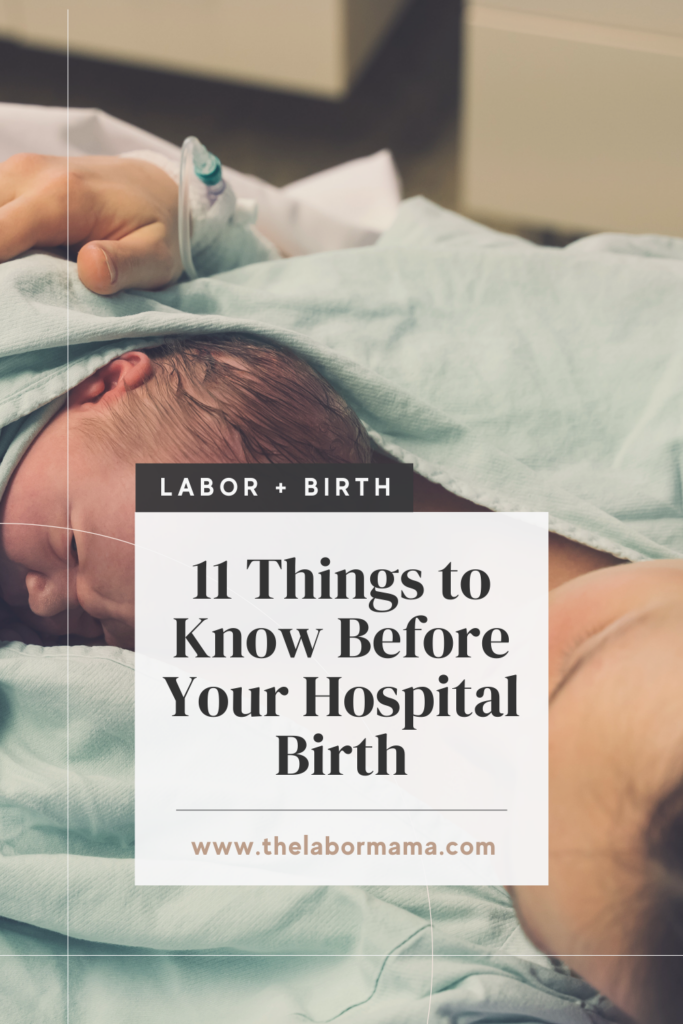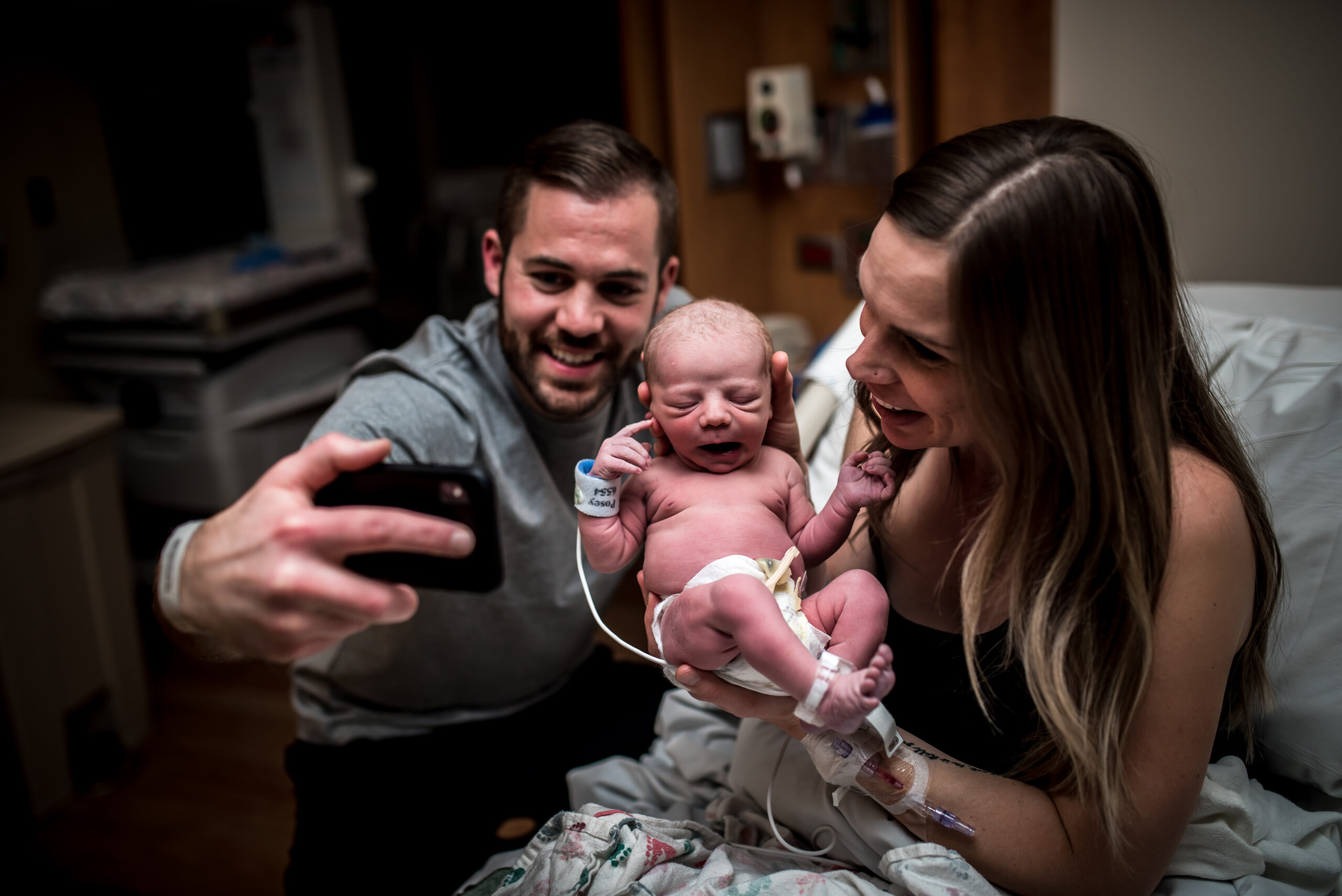How many weeks along are you? Are you getting close? Staring at that due date and wondering “when will you finally come out, baby?!” I’ve been there. I get it. Even though I was a labor nurse, I was convinced I wasn’t possibly going to go overdue, that I knew everything I could possibly know, and that there was absolutely nothing left for me to do.
But, as both a labor and postpartum nurse and as I’ve gone from one baby, to two, to three, I’ve realized that the whole “are you ready” list that many go by is missing quite a few things that I think are important to think through or prepare for. So, I want to give you 11 tips or ways to prepare before your hopsital birth. Then, you can really say “c’mon baby, I’m ready!”

But before we dive into all the things to know – Who is The Labor Mama and Why Am I Here?
Hey friend! I’m Lo – also known around here and social media as The Labor Mama. I’ve spent my nursing career in labor, delivery, and postpartum, have birthed 4 of my own babies, have labored thousands of mamas at the bedside, have taught thousands of students online, and have even delivered a few speedy little babies with my bare hands (oops).
Here at TLM, I offer online classes about birth, postpartum, newborn care, and breastfeeding to empower you the way everyone should be. The education + support I offer gives you experience, evidence, and empathy; you’re getting all of my years of “clinical” RN knowledge, honestly combined with my real experiences as a mama, nurse, and CLC. These are not your average hospital classes (those won’t do it, I promise), and honestly, birth, postpartum, and breastfeeding don’t follow a textbook or protocol anyway. You need to know so much more than that!
If you want to connect with me further, head to Instagram. There are hundreds of thousands of us over there learning together daily.
A note: This post may include affiliate links. This means if you make a purchase after clicking a link, I will earn a small commission (thank you)! Rest assured, this comes at no additional cost to you. You can read TLM’s full disclosure here.
11 Things to Know Before Labor Starts
I’m going to assume that you’ve taken a birth course, had your baby shower, prepped your nursery, washed the baby clothes – all of those types of things. Maybe you’re even in full nesting mode at this point and just looking for more things to do. First, I have to tell you “REST!” Second, if you haven’t taken a birth course yet, jump into mine and start bingeing! It’s all available to you, immediately after purchase (and for life, too). And if you’re really wanting to stay busy right now, peek at my Third Trimester Checklist to see what else you may want to consider doing. You can snag that here.
Ok, aside from all of that, let’s go over some things I’d love for you to know (or prep for) before you head to your hospital.
1. The hospital check-in process may feel clunky.
While hospitals do their best to make this seamless and easy, checking in can feel annoying or slow when you are in labor and just want to be in your space. Often, you will enter the hospital, have to check in at an ER counter or an admitting counter, and then be directed to the OB unit. Once you get to OB, you’ll then be checked in and placed in a room (often triage – see #2). If you take a birthplace tour, they should go over these processes for you.
But I also like to teach you to figure this out on your own too! I teach my students to actually hop in the car with their partner and take a fake practice drive to the hospital. Figure out where you’ll park, what doors you’ll go in, where the elevators or stairs would be, etc. Your “path” can change if it’s after hours, so figure that out too (usually the ER is going to be the spot to start).
If your hospital offers pre-admit or preregistration appointments, do those too. This can save you some time during the check-in process because you’ll have already answered many of the admit questions.
2. You may get sent back home.
Have you heard of OB triage? This is where most get sent when they show up on the OB unit with the “I think I’m in labor” (or any other concern). Unless it’s clearly obvious that you are in labor (you’re pushing, your water is broken and leaking, etc) or that there’s a problem, a triage RN will admit you and assess you in a triage space.
What that triage process looks like will depend on why you have shown up. But assuming you’re there because you think you’re in labor, this assessment includes things like vitals, monitoring the baby’s heart rate and your contractions, a head to toe interview of how you feel/what’s going on, and possibly checking your cervix or your amniotic fluids. If your doctor or midwife is around, they may be involved. But often, the RN does all the triage work, gets a good picture of what’s going on with you and baby, and then calls your provider and they decide if you should stay for labor or if you should head back home and come back in later on.
This is a great reason NOT to bring everything onto the unit with you unless you are certain it’s the real deal. I also like packing separate labor vs postpartum bags – see tip #5 for more on that.
3. Don’t sound the alarm.
This totally depends on you and your preferences, but you may want to hold off on letting anyone know you’re in labor or at the hospital until you know that it’s the “real deal” and they’re keeping you! Depending on who you have decided you want around, you could pick a certain time in the process, like after the IV, after the epidural, or after baby is born to be the “this is when we’ll notify you” timing.
In general, I always recommend communication like this being the job of the partner anyway. But to save either of you a likely barrage of texts or calls, it can be nice to wait to let anyone know until you have some clarity about what’s actually going on or what is next.
4. Things at a hospital take time.
Don’t get me wrong – if you show up ready to push that baby out, the team is going to show up for you and help you do it. But as you consider things like the 4-1-1 rule and “when should I go to the hospital,” don’t forget that the time from leaving your house to actually getting into the unit and into your space is more than just those minutes in the car.
You also want to think about drive time (and traffic), parking time, getting into the hopsital and to the unit, getting checked in, and possibly being triaged before they say “yes, let’s have a baby.” If you are wanting an epidural for pain control, you will need lab work drawn and resulted, an IV in place, some fluids in, and an available anesthesiologist – and this process usually takes at least 45 minutes from official admission.
I’m a huge fan of not going to the hospital too soon (see #7), but if you know you labor quickly, your contractions are already close, or you want that epidural, just remember all of these different timelines and how long things can actually take.

5. There might not be a room for you.
I think this one shocks mamas more than anything else sometimes. Who expects to show up and have the hospital say, “sorry, we don’t have a room to put you in?” But it is possible and can happen, so I want you to know.
Labor units can’t plan how many people will come into the unit in labor. Typically, they try to stagger scheduled procedures (inductions/cesareans) and staff appropriately, but it’s also really unpredictable. Sometimes, the unit fills up, no one has discharged or delivered, and there isn’t a room ready for you until someone does one of those things. This can mean you have to hang out in triage for a long time, and (very) rarely, it can even mean you have to deliver in triage.
If you are maybe in labor, they’ll also be less likely to admit you straight away (especially if there are one or no rooms left). In this situation, they may do the initial assessment (including a cervical exam) and then have you walk around the unit for an hour or two. They’ll then reassess things (check to see if the cervix has made change) before making the decision of truly admitting you and figuring out how to get you into a labor room!
6. Consider packing 2 bags.
Hang on, hear me out! I’m not saying pack more stuff. But I am suggesting a bag for what you’d need for labor and then a bag for the additional postpartum supplies. This way, if you’re in a bit of a hurry when you show up OR if you get sent home, you aren’t lugging a ton in and out. Once baby is born and you get to your postpartum space, your partner can easily go get those postpartum things.
If you want my hospital packing checklist, you can snag that here. You’ll see suggestions for you, for partner, and for baby. Specific for a labor bag? I’d throw in:
- Your birth plan
- Your own gown (if you want one)
- Hairties
- Chapstick
- Comfort measure tools
- A portable fan
- Essential oils/diffusing tools
- Affirmations
- Birthing balls (check if your hospital provides these)
- Bra/swimwear (if you want for birthing or getting in water)
- Phone charger
- Bluetooth speaker
- Gum/hard candies/honey sticks
7. Stay home as long as you can.
I know, this is all about going to the hospital. But honestly? If it is safe to do so, stay home as long as you are able! Unless you are wanting an epidural, the hospital actually can’t do a ton for you once you show up. Yes, you’ll get confirmation that you’re actually in labor, but you’ll also have to make choices about eating, IVs, what to wear, who you do and don’t want around, etc.
At home, you have complete control and freedoms over all of these things. Home is also the place where most feel very safe, in control, and “free” to physiologically labor, and these things are really, really helpful when moving through the stages of labor.
Sometimes, the processes of admission, the questions, or the presence of new people and sounds in your labor space can actually interfere with the labor process and cause it to stall or slow down. While you and your team can do the work of turning that environment into one that encourages labor to kick in again, it’s nice to show up at a time in which that change of space won’t stop what’s going on!
8. Your partner can go in and out.
This goes along with the idea of NOT bringing it all with you to get admitted or triaged. Again, that single labor bag can be awesome so that even if you are in a hurry, you can quickly grab that and get moving. Then, as there’s a moment to do so, your partner can go back outside and grab snacks or anything that you’re missing.
During postpartum, they can also do this! They can go out and get better food if the hospital food isn’t great, go home if your postpartum stay is longer than you were expecting and you need more clothes, etc. You’re required to stay until you’re discharged – but they’re not!
9. Your postpartum stay will probably be longer than your labor stay.
Barring an incredibly long induction process, most will stay at the hopsital longer as a postpartum patient then they will as a labor patient. Again, this is why I suggest not bringing a ton of stuff in for labor and having that second bag for after birth.
After a vaginal delivery, most insurance providers allow for you to stay 1-2 nights. After a cesarean delivery, it’s usually 3-4 nights. Most hospitals don’t want to discharge you until at least the post-birth 24-hour mark. This allows them the time they’d like to assess you, your body, and your bleeding, assess baby’s feeding, vitals, and transition to life, check in on baby’s weight and jaundice, and do any administrations of medicines, vaccines, and the newborn screen.
10. Install your carseat (or base) before you go to the hospital.
Yes, in theory your partner could go out and do this once baby is here. But I’d highly suggest you do it before birth and do the work to have it appropriately and safely installed and ready. Read the manual for both your vehicle and the seat. Consult carseat professionals (make sure they are CPST certified). Make sure the seat itself is set up for a tiny newborn.
Occasionally, hospitals employ carseat professionals and they can help you with some of this. But many don’t (or they’re only there certain hours). Legally, your RN is not supposed to help you either! You really do have to know how to safely use that seat.
I would NOT bring the carseat onto the unit until you are close to your discharge time. This is definitely something that your partner can go and get out of the car when you’re getting ready to load up. If you have a NICU baby, they’ll will sometimes do something called a carseat test. They can give you more information on that if it’s necessary.
11. Getting sleep or rest is tough.
Finding peace in a hospital can be tough both in labor and after! This is partly why I love to encourage you to stay home as long as you’re able. Even when you have an RN doing their very best to give you space, peace, quiet, etc. a hospital has circulating staff like obstetricians, midwives, pediatricians, lab technicians, IV teams, anesthesia, pediatricians, and delivery nurses who all may come in and out at different times depending on what’s going on in your process.
? One thing you can do? Ask your RN to hang a sign on the door that says something like “Please ask RN before entering.” This can help slow the flow of people in and out and can be really useful for postpartum. After birth, you can also ask the RN to “group cares.” This means that they try to do multiple tasks for you and baby at one time (lhelp you out of bed, check vitals, administer any meds, and check in on feeding) and then stay back out for another 2-3 hour chunk unless something comes up or you call out and need them. This isn’t always possible, but I’ve done it OFTEN and it really does work and is worth asking.
If this is the kind of detailed information you love and want to help you navigate your birth and postpartum with way more confidence, check out my birth course, my postpartum course, and my breastfeeding course. (TLM VIP All-Access can get you into all of them)! Once you join, you’ll have instant access to 50+ modules (full of video lessons, PDFs, and guides) that will walk through your pregnancy, birth, and postpartum, giving you instant and continual access to the information you need to have a better story, starting right now.
The takeaway on things to know before your hospital birth
I love, love, love sharing this type of information because it feels like the real stuff, the “why didn’t they tell me this in my tour?” type stuff. Can you labor and deliver without knowing or doing all of this? Of course you can! But I think this kind of stuff is what makes you really feel ready. Situations or circumstances like the ones that I chatted about here won’t shock you, scare you, or surprise you. Instead, you’ll be able to say “oh, I knew about this” and just keep on rocking your labor process.
What else would you add to the “know this before your hospital birth convo?” Let me know in the comments; I’d love your thoughts too. xx – Lo
More resources (and freebies!) for you to take a peek at:
- Comprehensive Birth Plan and Birth Priorities templates
- A complete Third Trimester Checklist
- The RN + mama of 4 Ultimate Packing List
- The Labor Mama online classes for every family





